Edyn: Dynamic Signaling of Changes to Forests Using Exponentially Weighted Moving Average Charts
Abstract
:1. Introduction
2. Materials and Methods
2.1. Reference Data and Spectral Data
2.2. Review and Updates to EWMACD
Parameter Updates
2.3. Edyn
2.4. Strengths and Limitations of EWMACD/Edyn
2.5. Agreement Assessment
3. Results
4. Discussion
5. Conclusions
Acknowledgments
Author Contributions
Conflicts of Interest
References
- Cohen, W.B.; Goward, S.N. Landsat’s role in ecological applications of remote sensing. BioScience 2004, 54, 535–545. [Google Scholar] [CrossRef]
- Hansen, M.C.; Loveland, T.R. A review of large area monitoring of land cover change using Landsat data. Remote Sens. Environ. 2012, 122, 66–74. [Google Scholar] [CrossRef]
- Hirschmugl, M.; Gallaun, H.; Dees, M.; Datta, P.; Deutscher, J.; Koutsias, N.; Schardt, M. Methods for mapping forest disturbance and degradation from optical earth observation data: A review. Curr. For. Rep. 2017, 3, 32–45. [Google Scholar] [CrossRef]
- Potapov, P.V.; Turubanova, S.A.; Hansen, M.C.; Adusei, B.; Broich, M.; Altstatt, A.; Mane, L.; Justice, C.O. Quantifying forest cover loss in Democratic Republic of the Congo, 2000–2010, with Landsat ETM+ data. Remote Sens. Environ. 2012, 122, 106–116. [Google Scholar] [CrossRef]
- Brooks, E.B.; Wynne, R.H.; Thomas, V.A.; Blinn, C.E.; Coulston, J.W. On-the-fly massively multitemporal change detection using statistical quality control charts and Landsat data. IEEE Trans. Geosci. Remote Sens. 2014, 52, 3316–3332. [Google Scholar] [CrossRef]
- Huang, C.; Goward, S.N.; Masek, J.G.; Thomas, N.; Zhu, Z.; Vogelmann, J.E. An automated approach for reconstructing recent forest disturbance history using dense Landsat time series stacks. Remote Sens. Environ. 2010, 114, 183–198. [Google Scholar] [CrossRef]
- Kennedy, R.E.; Yang, Z.; Cohen, W.B. Detecting trends in forest disturbance and recovery using yearly Landsat time series: 1. LandTrendr—Temporal segmentation algorithms. Remote Sens. Environ. 2010, 114, 2897–2910. [Google Scholar] [CrossRef]
- Vogelmann, J.E.; Xian, G.; Homer, C.; Tolk, B. Monitoring gradual ecosystem change using Landsat time series analyses: Case studies in selected forest and rangeland ecosystems. Remote Sens. Environ. 2012, 122, 92–105. [Google Scholar] [CrossRef]
- Zhu, Z.; Woodcock, C.E. Continuous change detection and classification of land cover using all available Landsat data. Remote Sens. Environ. 2014, 144, 152–171. [Google Scholar] [CrossRef]
- Moisen, G.G.; Meyer, M.C.; Schroeder, T.A.; Liao, X.; Schleeweis, K.G.; Freeman, E.A.; Toney, C. Shape selection in Landsat time series: A tool for monitoring forest dynamics. Glob. Chang. Biol. 2016, 22, 3518–3528. [Google Scholar] [CrossRef] [PubMed]
- Hughes, M.; Kaylor, S.; Hayes, D. Patch-based forest change detection from Landsat time series. Forests 2017, 8, 166. [Google Scholar] [CrossRef]
- McDowell, N.G.; Coops, N.C.; Beck, P.S.A.; Chambers, J.Q.; Gangodagamage, C.; Hicke, J.A.; Huang, C.Y.; Kennedy, R.; Krofcheck, D.J.; Litvak, M.; et al. Global satellite monitoring of climate-induced vegetation disturbances. Trends Plant Sci. 2015, 20, 114–123. [Google Scholar] [CrossRef] [PubMed]
- Cohen, W.B.; Yang, Z.; Stehman, S.V.; Schroeder, T.A.; Bell, D.M.; Masek, J.G.; Huang, C.; Meigs, G.W. Forest disturbance across the conterminous United States from 1985–2012: The emerging dominance of forest decline. For. Ecol. Manag. 2016, 360, 242–252. [Google Scholar] [CrossRef]
- Cohen, W.; Healey, S.; Yang, Z.; Stehman, S.; Brewer, C.; Brooks, E.; Gorelick, N.; Huang, C.; Hughes, M.; Kennedy, R.; et al. How similar are forest disturbance maps derived from different Landsat time series algorithms? Forests 2017, 8, 98. [Google Scholar] [CrossRef]
- Neigh, C.S.R.; Bolton, D.K.; Williams, J.J.; Diabate, M. Evaluating an automated approach for monitoring forest disturbances in the Pacific Northwest from logging, fire and insect outbreaks with Landsat time series data. Forests 2014, 5, 3169–3198. [Google Scholar] [CrossRef]
- Kurz, W.A.; Dymond, C.C.; Stinson, G.; Rampley, G.J.; Neilson, E.T.; Carroll, A.L.; Ebata, T.; Safranyik, L. Mountain pine beetle and forest carbon feedback to climate change. Nature 2008, 452, 987–990. [Google Scholar] [CrossRef] [PubMed]
- Running, S.W. Climate change—Ecosystem disturbance, carbon, and climate. Science 2008, 321, 652–653. [Google Scholar] [CrossRef] [PubMed]
- Seidl, R.; Schelhaas, M.J.; Rammer, W.; Verkerk, P.J. Increasing forest disturbances in Europe and their impact on carbon storage. Nat. Clim. Chang. 2014, 4, 806–810. [Google Scholar] [CrossRef] [PubMed]
- Exponentially Weighted Moving Average Change Detection—Script and Sample Data. Available online: https://vtechworks.lib.vt.edu/handle/10919/50543?show=full (accessed on 2 June 2017).
- Raza, S.M.M.; Siddiqi, A.F. EWMA and DEWMA control charts for poisson-exponential distribution: Conditional median approach for censored data. Qual. Reliab. Eng. Int. 2017, 33, 387–399. [Google Scholar] [CrossRef]
- Reynolds, M.R.; Stoumbos, Z.G. Comparisons of some exponentially weighted moving average control charts for monitoring the process mean and variance. Technometrics 2006, 48, 550–567. [Google Scholar] [CrossRef]
- Woodall, W.H.; Mahmoud, M.A. The inertial properties of quality control charts. Technometrics 2005, 47, 425–436. [Google Scholar] [CrossRef]
- Cohen, W.B.; Yang, Z.; Kennedy, R. Detecting trends in forest disturbance and recovery using yearly Landsat time series: 2. TimeSync—Tools for calibration and validation. Remote Sens. Environ. 2010, 114, 2911–2924. [Google Scholar] [CrossRef]
- Zhu, Z.; Woodcock, C.E. Object-based cloud and cloud shadow detection in Landsat imagery. Remote Sens. Environ. 2012, 118, 83–94. [Google Scholar] [CrossRef]
- Tucker, C.J. Red and photographic infrared linear combinations for monitoring vegetation. Remote Sens. Environ. 1979, 8, 127–150. [Google Scholar] [CrossRef]
- Brooks, E.B.; Thomas, V.A.; Wynne, R.H.; Coulston, J.W. Fitting the multitemporal curve: A fourier series approach to the missing data problem in remote sensing analysis. IEEE Trans. Geosci. Remote Sens. 2012, 50, 3340–3353. [Google Scholar] [CrossRef]
- Hermance, J.F. Stabilizing high-order, non-classical harmonic analysis of NDVI data for average annual models by damping model roughness. Int. J. Remote Sens. 2007, 28, 2801–2819. [Google Scholar] [CrossRef]
- Schroeder, T.A.; Schleeweis, K.G.; Moisen, G.G.; Toney, C.; Cohen, W.B.; Freeman, E.A.; Yang, Z.Q.; Huang, C.Q. Testing a Landsat-based approach for mapping disturbance causality in U.S. forests. Remote Sens. Environ. 2017, 195, 230–243. [Google Scholar] [CrossRef]
- Zhu, Z.; Woodcock, C.E.; Olofsson, P. Continuous monitoring of forest disturbance using all available Landsat imagery. Remote Sens. Environ. 2012, 122, 75–91. [Google Scholar] [CrossRef]
- Masek, J.G.; Goward, S.N.; Kennedy, R.E.; Cohen, W.B.; Moisen, G.G.; Schleeweis, K.; Huang, C.Q. United States forest disturbance trends observed using Landsat time series. Ecosystems 2013, 16, 1087–1104. [Google Scholar] [CrossRef]
- Sun, B.; Chen, X.; Zhou, Q. Analyzing the uncertainties of ground validation for remote sensing land cover mapping in the era of big geographic data. In Spatial Data Handling in Big Data Era; Zhou, C., Su, F., Harvey, F., Xu, J., Eds.; Springer Nature: Singapore, 2017; pp. 31–38. [Google Scholar]
- Jin, S.; Yang, L.; Danielson, P.; Homer, C.; Fry, J.; Xian, G. A comprehensive change detection method for updating the National Land Cover Database to circa 2011. Remote Sens. Environ. 2013, 132, 159–175. [Google Scholar] [CrossRef]
- Healey, S.P.; Cohen, W.B.; Zhiqiang, Y.; Brewer, C.K.; Brooks, E.B.; Gorelick, N.; Hernandez, A.J.; Huang, C.; Hughes, M.J.; Kennedy, R.E.; et al. Mapping forest change using stacked generalization: An ensemble approach. Remote Sens. Environ. 2017. in review. [Google Scholar]
- Saxena, R.; Watson, L.T.; Wynne, R.H.; Thomas, V.A. Scaling constituent algorithms of a trend and change detection polyalgorithm. In Proceedings of the 2017 Spring Simulation Multi Conference on High Performance Computing Symposium, Virginia Beach, VA, USA, 23–26 April 2017. [Google Scholar]
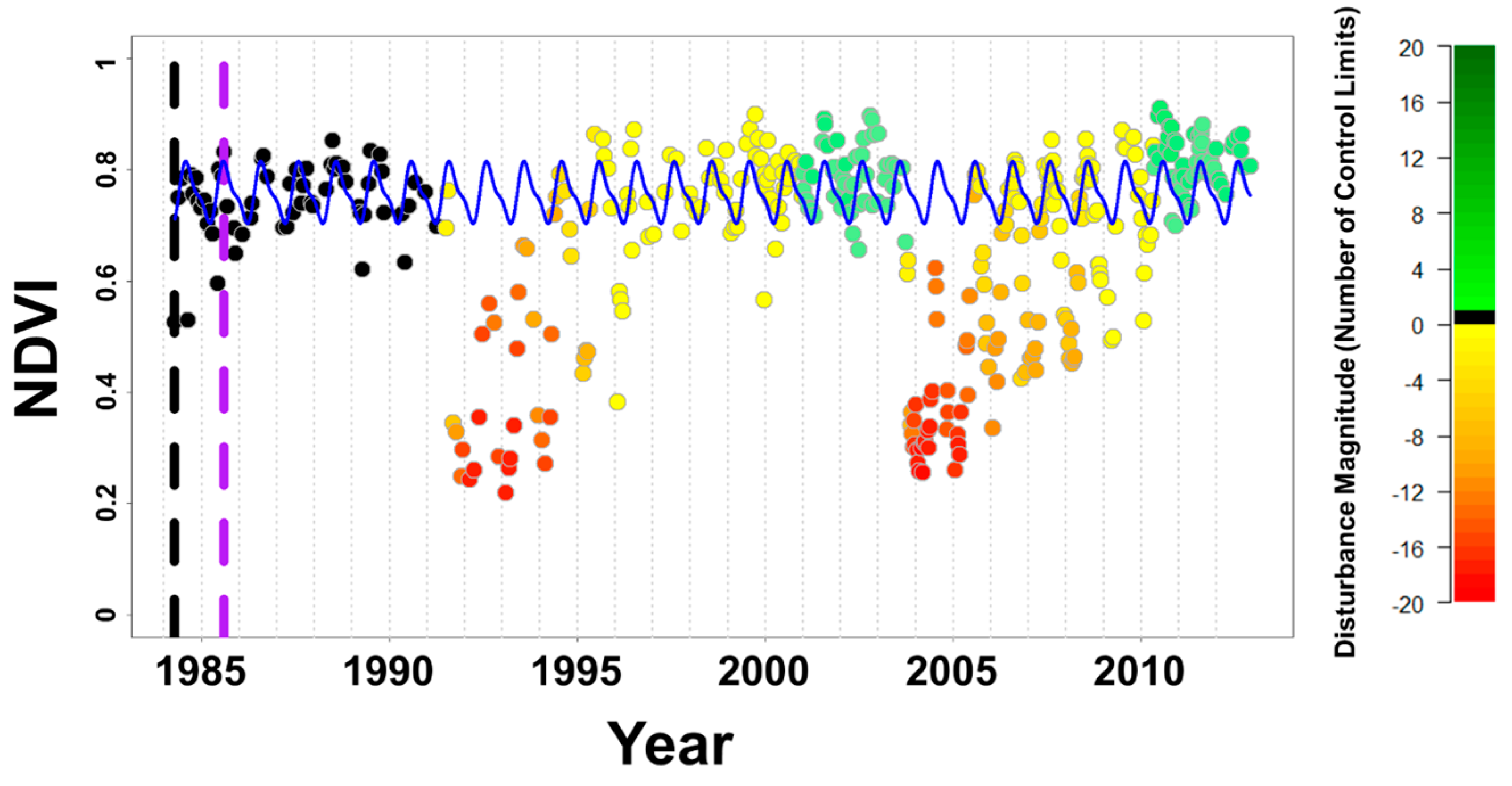
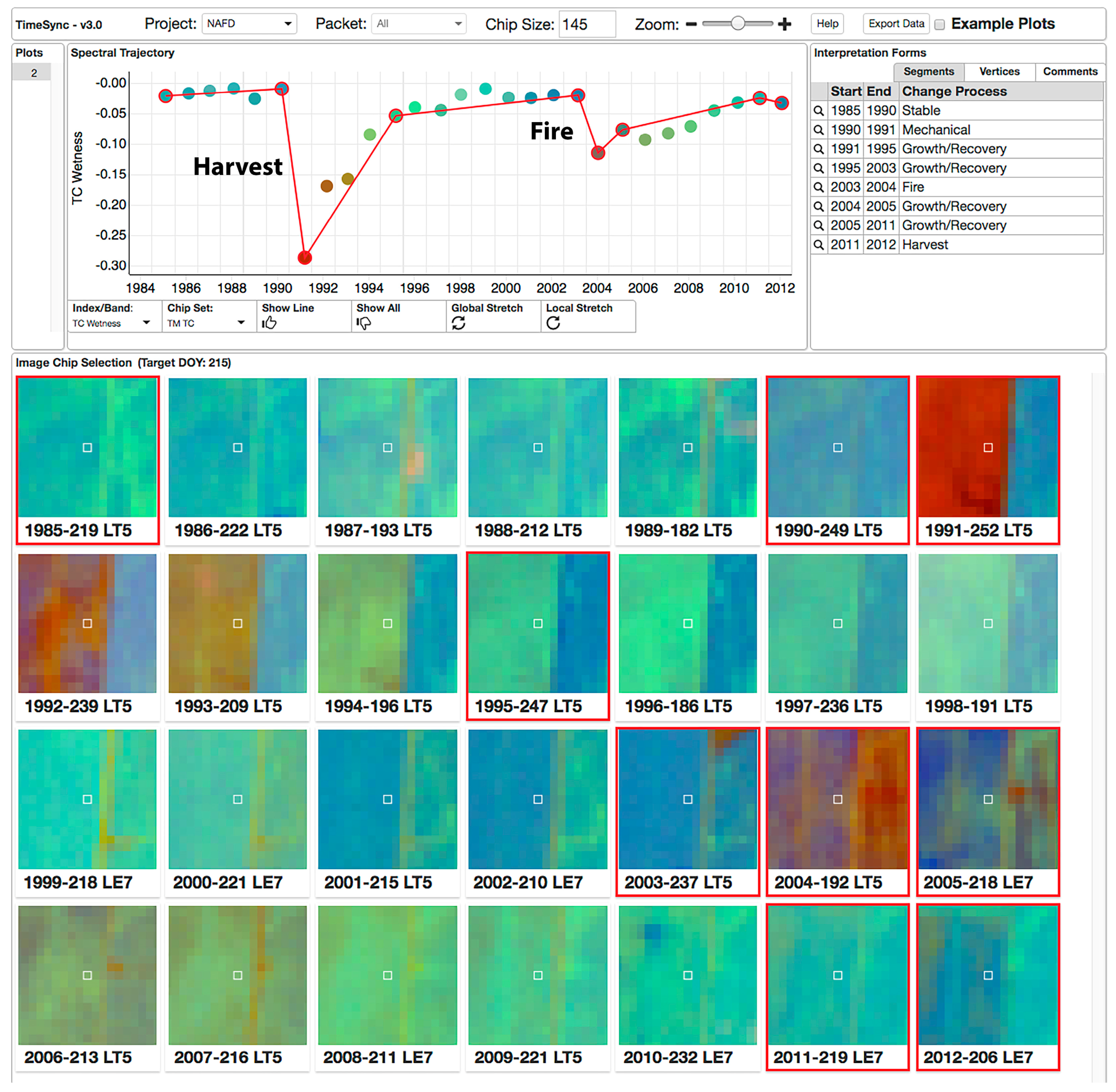
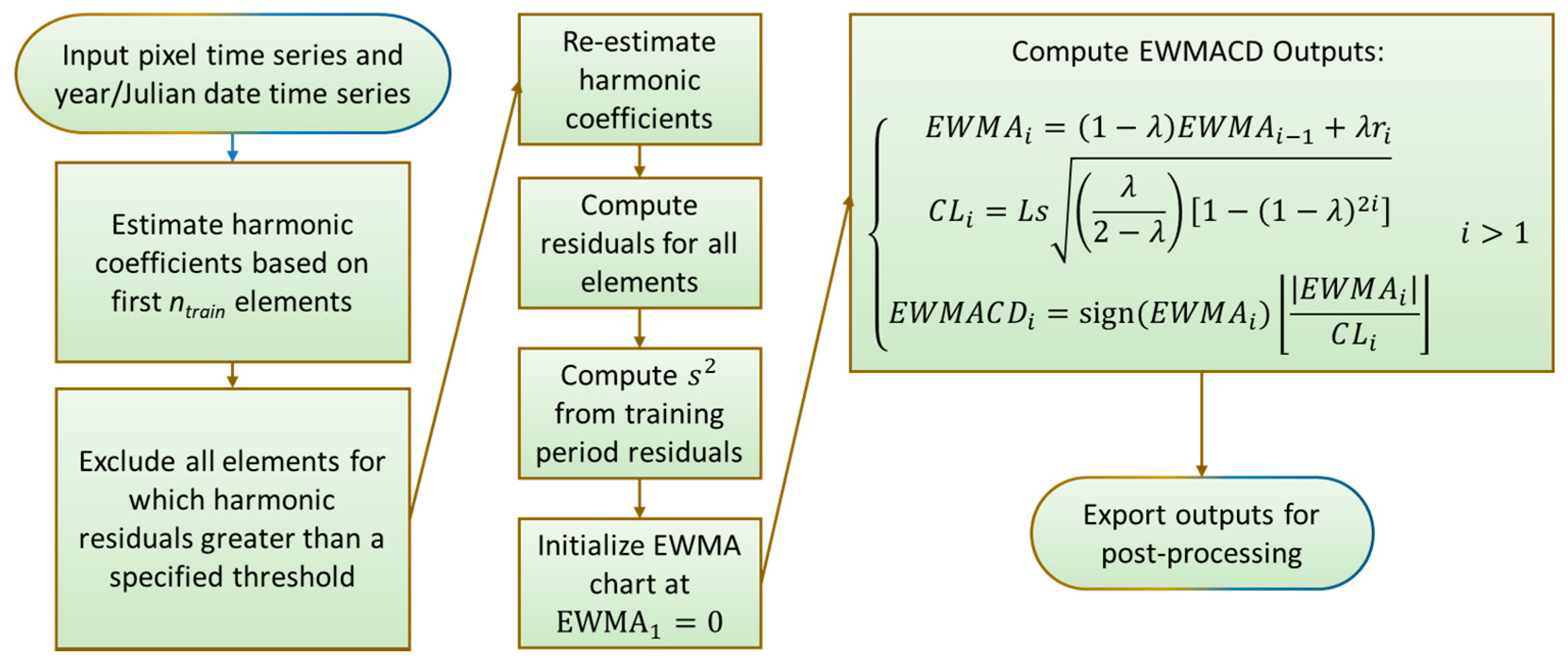
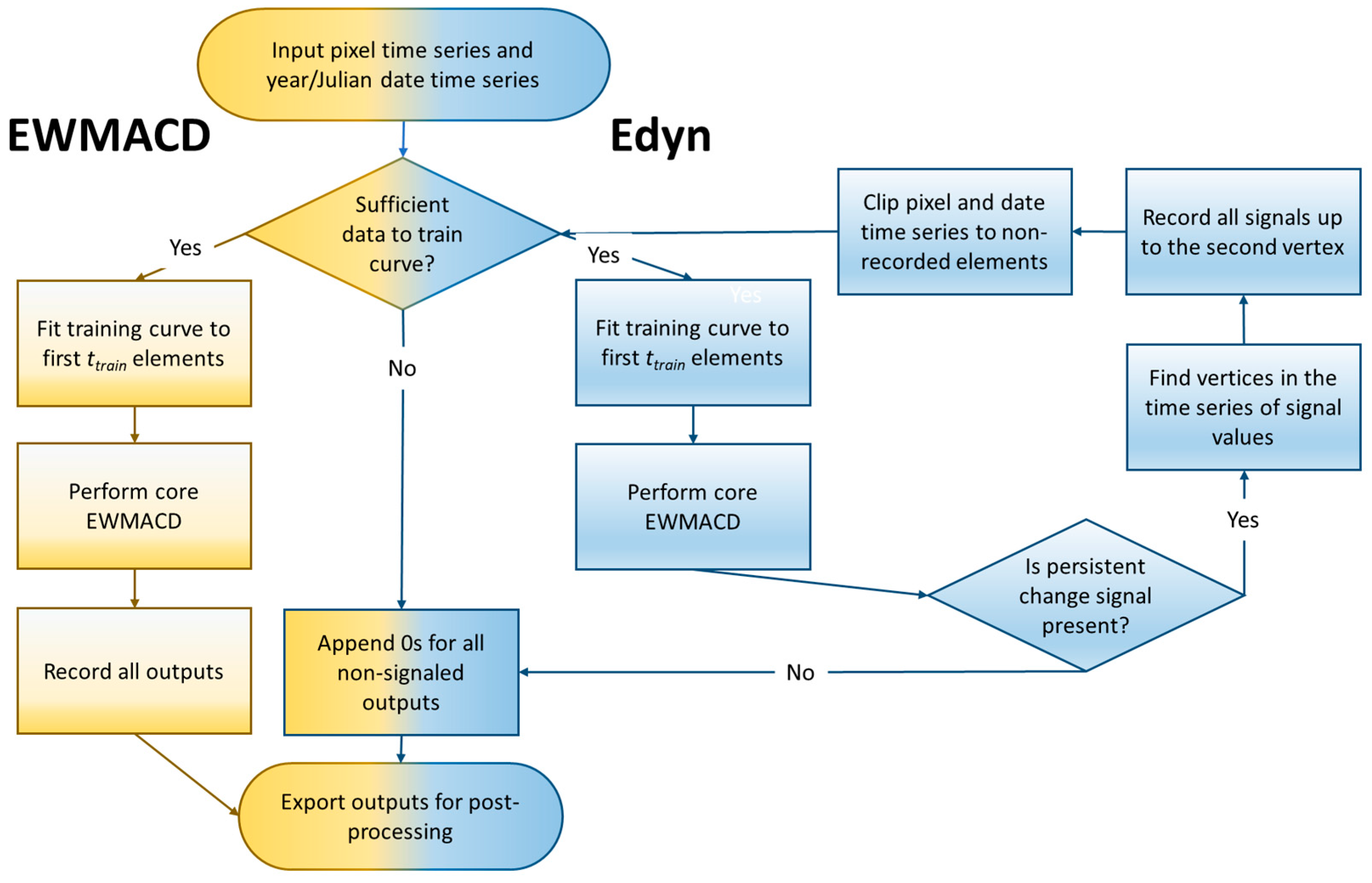


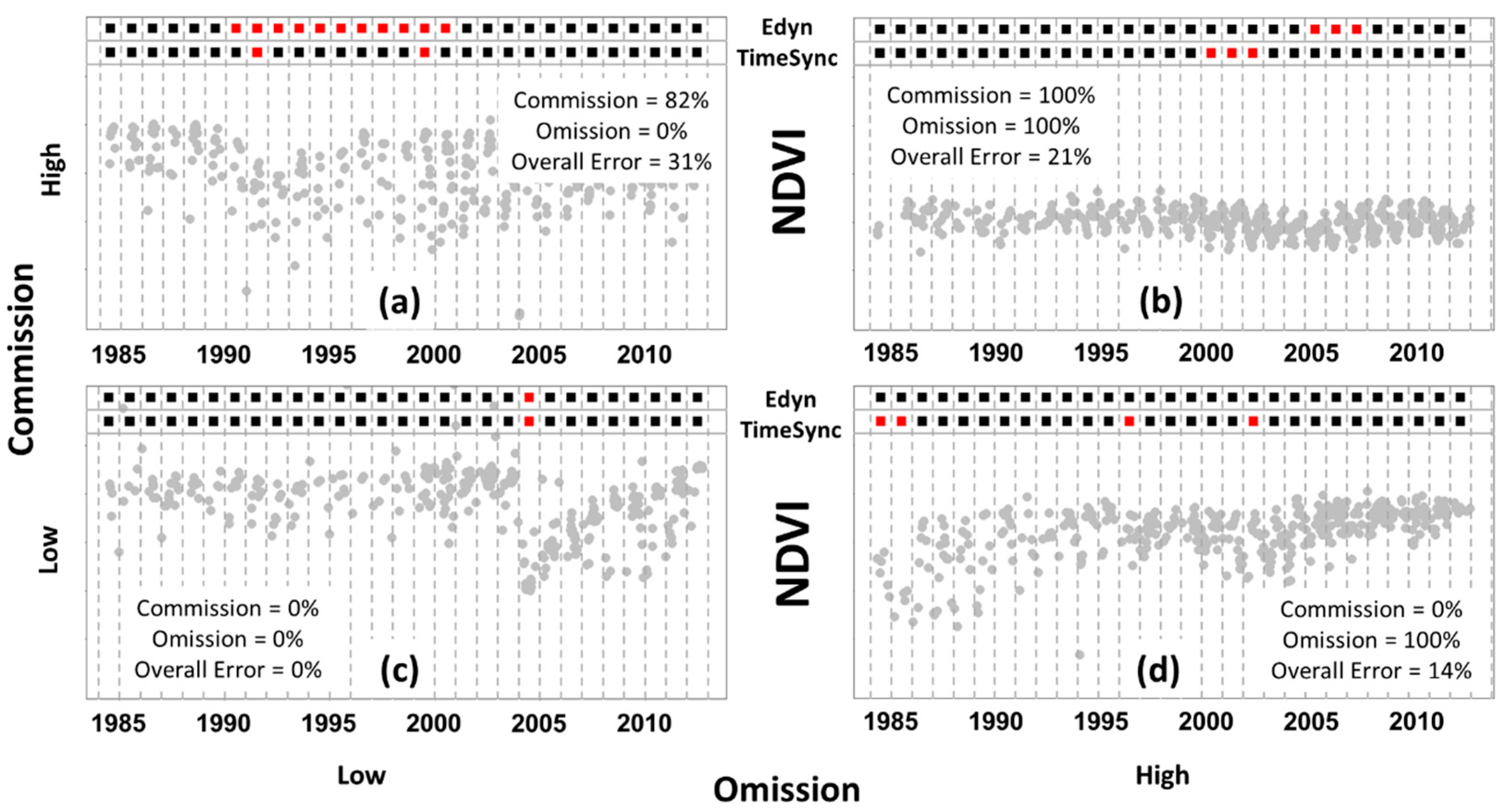
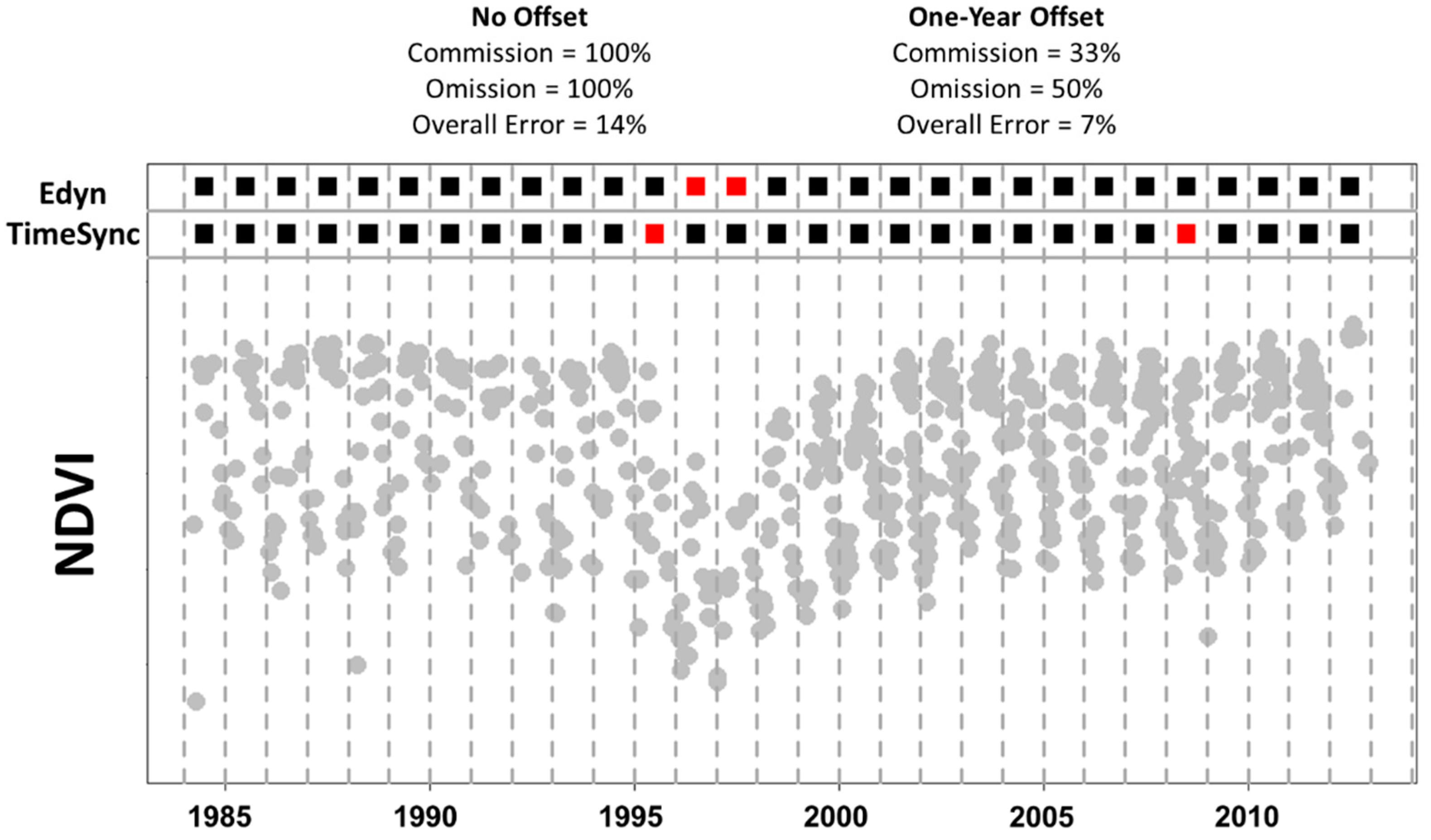
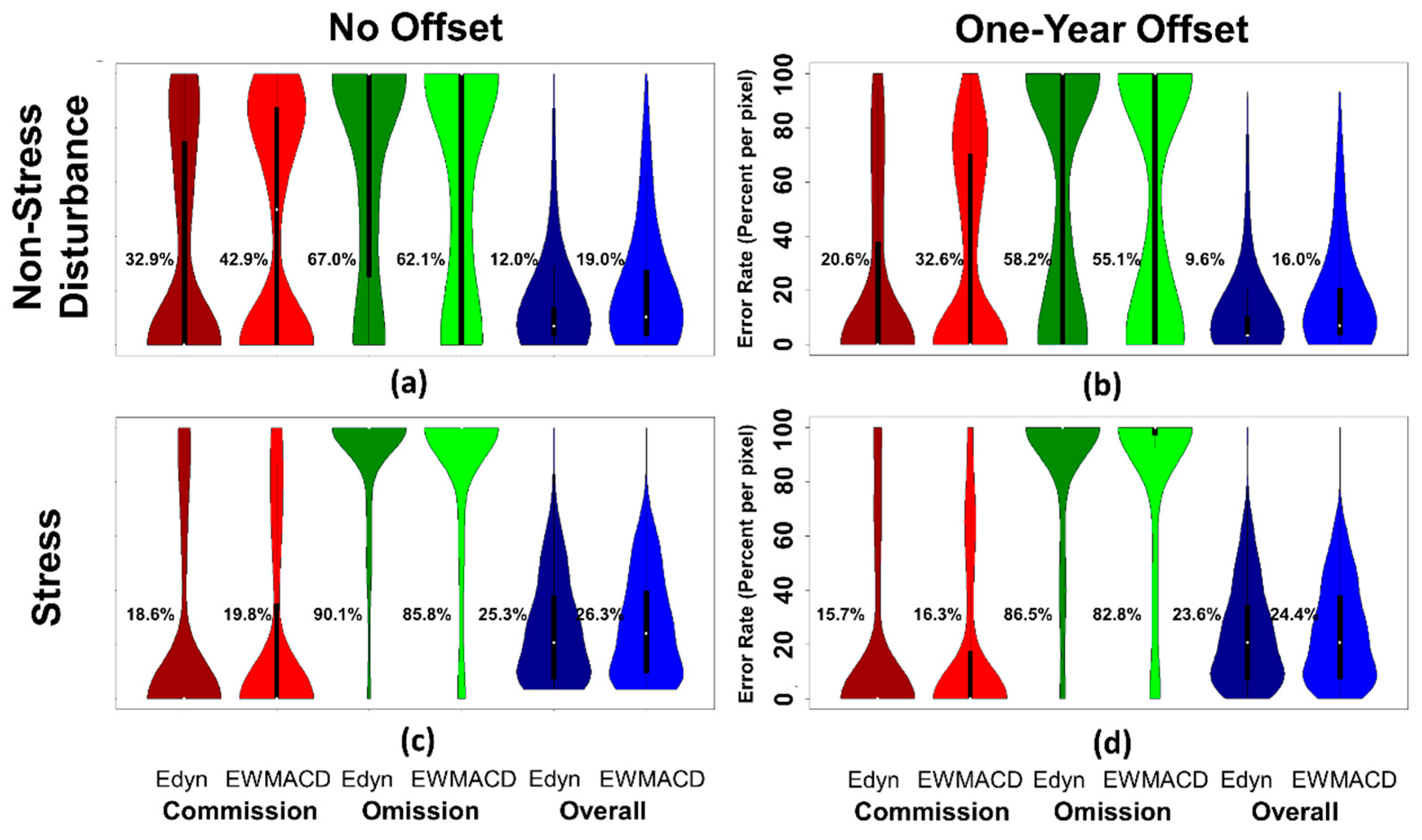
| Parameter | Description | Value |
|---|---|---|
| Smoothing parameter; weight of current observation against prior history | 0.3 | |
| Control limit; number of standard deviations away from 0 required to signal | 5 | |
| Proportion of a typical year desired to designate “consistent” change | 1 | |
| Number of cosine and sine harmonics used in the curve-fitting, respectively | 2, 2 | |
| Minimum required to accept harmonic curve | 0.7 |
| Pixel Subset | Total Pixels | Commission | Omission | Overall Error | F1 Score | ||||
|---|---|---|---|---|---|---|---|---|---|
| Edyn | EWMACD | Edyn | EWMACD | Edyn | EWMACD | Edyn | EWMACD | ||
| All Forested Pixels | 3751 | 20.6% * (15.8% *) | 24.0% * (19.9% *) | 34.6% * (26.7%*) | 32.5% * (25.4% *) | 7.8% * (6.7% *) | 11.1% * (9.7% *) | 0.54 * (0.63 *) | 0.52 * (0.60 *) |
| Disturbed Forested Pixels | 1620 | 31.1% * (19.9% *) | 39.9% * (30.4% *) | 70.0% * (61.9% *) | 65.2% * (58.7% *) | 13.7% * (11.4% *) | 19.9% * (17.1% *) | 0.19 * (0.30 *) | 0.13 * (0.23 *) |
| Disturbed Forested Pixels (No Stress) | 1408 | 32.9% * (20.6% *) | 42.9% * (32.6% *) | 67.0% * (58.2% *) | 62.1% * (55.1% *) | 12.0% * (9.6% *) | 19.0% * (16.0% *) | 0.21 * (0.33 *) | 0.13 * (0.25 *) |
| Disturbed Forested Pixels (Stress Only) | 212 | 18.60% −15.70% | 19.80% −16.30% | 90.1% * (86.5% *) | 85.8% * (82.8% *) | 25.30% −23.60% | 26.30% −24.40% | 0.09 −0.12 | 0.1 −0.13 |
| TimeSync Disturbance Class | Severe [−20, −3) | Moderate [−3, −1) | Subtle [−1, 0) | No signal [0, 1) | Growth [1, 20] |
|---|---|---|---|---|---|
| Edyn | |||||
| All Disturbances | 172 (4.4%) | 371 (9.5%) | 393 (10.1%) | 2734 (70.2%) | 223 (5.7%) |
| Fire | 13 (7.5%) | 37 (21.4%) | 24 (13.9%) | 92 (53.2%) | 7 (4.0%) |
| Harvest | 89 (5.7%) | 195 (12.5%) | 200 (12.9%) | 987 (63.6%) | 80 (5.2%) |
| Other | 67 (7.8%) | 99 (11.6%) | 91 (10.7%) | 564 (66.0%) | 33 (3.9%) |
| Stress | 3 (0.2%) | 40 (3.0%) | 78 (5.9%) | 1091 (83.0%) | 103 (7.8%) |
| Stable | 151 (0.2%) | 735 (1.2%) | 1715 (2.8%) | 54,113 (89.1%) | 4031 (6.6%) |
| Recovery | 285 (0.7%) | 952 (2.2%) | 1623 (3.7%) | 34,232 (78.9%) | 6300 (14.5%) |
| EWMACD | |||||
| All Disturbances | 325 (8.3%) | 464 (11.9%) | 360 (9.2%) | 2321 (59.6%) | 423 (10.9%) |
| Fire | 38 (22.0%) | 44 (25.4%) | 18 (10.4%) | 56 (32.4%) | 17 (9.8%) |
| Harvest | 146 (9.4%) | 210 (13.5%) | 172 (11.1%) | 838 (54.0%) | 185 (11.9%) |
| Other | 120 (14.1%) | 122 (14.3%) | 83 (9.7%) | 487 (57.0%) | 42 (4.9%) |
| Stress | 21 (1.6%) | 88 (6.7%) | 87 (6.6%) | 940 (71.5%) | 179 (13.6%) |
| Stable | 340 (0.6%) | 1052 (1.7%) | 2243 (3.7%) | 50,608 (83.3%) | 8103 (10.7%) |
| Recovery | 934 (2.2%) | 1755 (4.0%) | 2825 (6.5%) | 29,775 (68.6%) | 6502 (18.7%) |
| Algorithm Signal | Not Disturbed | Harvest | Fire | Decline | Wind | Other | All Disturbances |
|---|---|---|---|---|---|---|---|
| Edyn | |||||||
| Not Disturbed | 30,208 | 406 | 30 | 890 | 43 | 146 | 1515 |
| Disturbed | 1713 | 234 | 24 | 114 | 18 | 60 | 450 |
| Omission | N/A | 63.4% | 55.6% | 88.6% | 70.5% | 70.9% | 77.1% |
| EWMACD | |||||||
| Not Disturbed | 28,388 | 401 | 19 | 823 | 42 | 132 | 1417 |
| Disturbed | 3533 | 239 | 35 | 181 | 19 | 74 | 548 |
| Omission | N/A | 62.7% | 35.2% | 82.0% | 68.9% | 64.1% | 72.1% |
© 2017 by the authors. Licensee MDPI, Basel, Switzerland. This article is an open access article distributed under the terms and conditions of the Creative Commons Attribution (CC BY) license (http://creativecommons.org/licenses/by/4.0/).
Share and Cite
Brooks, E.B.; Yang, Z.; Thomas, V.A.; Wynne, R.H. Edyn: Dynamic Signaling of Changes to Forests Using Exponentially Weighted Moving Average Charts. Forests 2017, 8, 304. https://doi.org/10.3390/f8090304
Brooks EB, Yang Z, Thomas VA, Wynne RH. Edyn: Dynamic Signaling of Changes to Forests Using Exponentially Weighted Moving Average Charts. Forests. 2017; 8(9):304. https://doi.org/10.3390/f8090304
Chicago/Turabian StyleBrooks, Evan B., Zhiqiang Yang, Valerie A. Thomas, and Randolph H. Wynne. 2017. "Edyn: Dynamic Signaling of Changes to Forests Using Exponentially Weighted Moving Average Charts" Forests 8, no. 9: 304. https://doi.org/10.3390/f8090304





